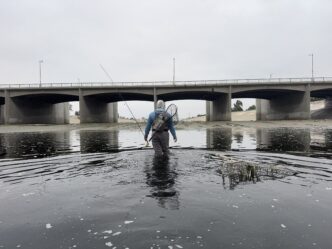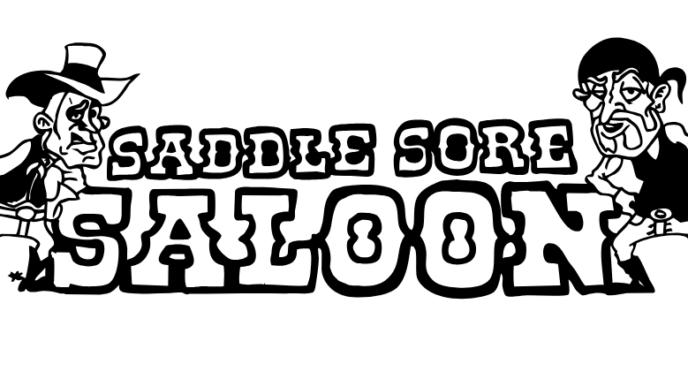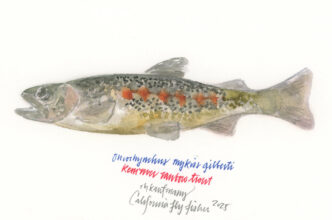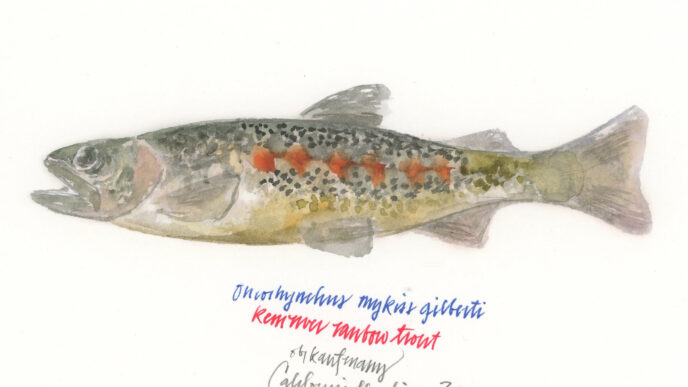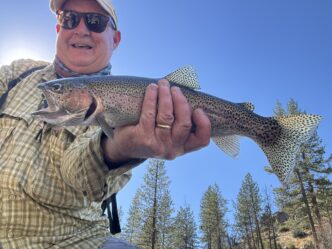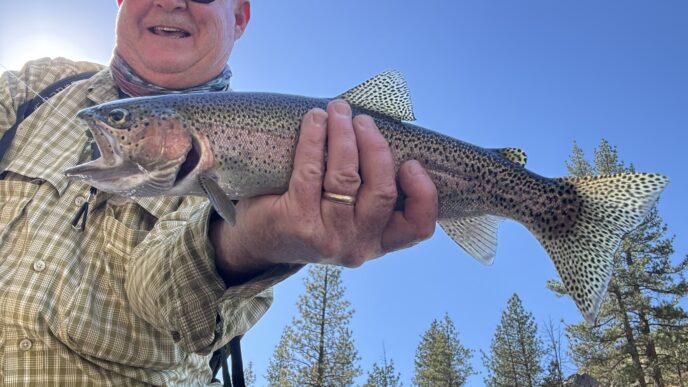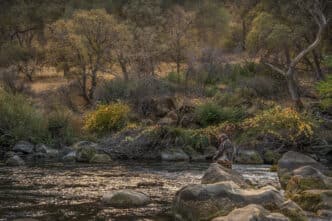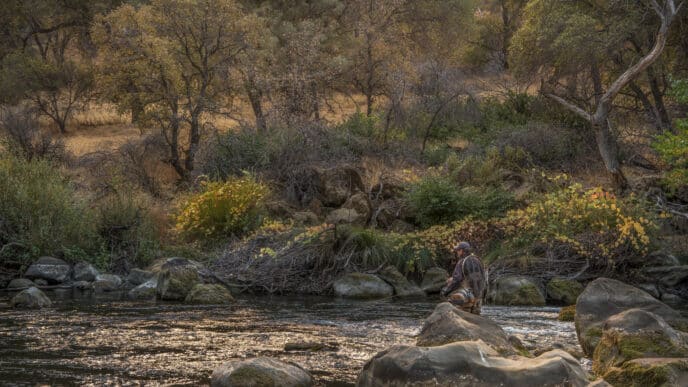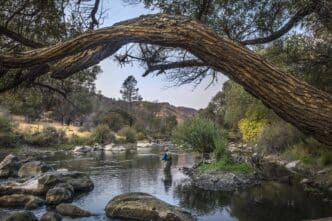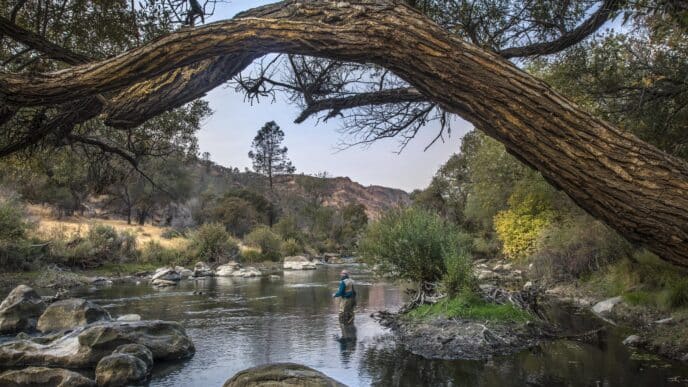Standing atop the Hollywood Hills, it’s easy to see why Los Angeles might just be the best urban fly-fishing destination in America.
To the north and east, rugged foothills; to the west, endless Pacific shoreline. A river runs through it, and urban lakes are scattered throughout its neighborhoods. Few places offer such a blend of angling opportunity within a single metropolitan sprawl.
From the mountains to the sea—and dozens of points in between—Los Angeles offers a fly-fishing diversity that rivals its human one. And just like the city itself, it requires patience, understanding, and maybe a bit of movie-set magic to fully appreciate all the area has to offer.
The rhythm of Los Angeles beats to a unique mix of sirens, helicopters, palm trees, and freeways. The latter, often clogged, are a lifeline of arteries running through Los Angeles. Avoiding peak-hour congestion is one of the first strategies for getting around the vast landscape of Southern California.
The Mediterranean climate of Southern California greets you the moment you arrive. Normally balmy with very few off days, outings can be planned year-round. Whether exploring the foothills, taking to the beach, or stopping off somewhere in between, L.A. offers fly-fishing opportunities to suit any schedule. On top of that, with so many easy jumping off points for fishable areas, ease of access is just another reason L.A. is the number one urban fly fishing destination.
Heritage and Hollywood
Though it may not boast the gear-manufacturing legacy like San Francisco (see Spring 2025 edition of California Fly Fisher), Los Angeles is no slouch when it comes to fly-fishing pedigree. World-renowned fly tyers like John Van Derhoof and Bill Blackstone helped shape the regional craft, while clubs like the 100-year-old Long Beach Casting Club and the 78-year-old Pasadena Casting Club anchor a deeply rooted community. These clubs, along with a dozen others that are in Fly Fishers International’s Southwest Council and in close proximity to L.A., represent thousands of dedicated anglers who practice the art of fly fishing and reflect the diverse populations of the region.
And then there’s Hollywood. L.A.’s entertainment legacy has played a subtle yet powerful role in elevating fly-fishing’s cultural presence. Few anglers haven’t been stirred by A River Runs Through It or Mending the Line. A-list enthusiasts—from Harrison Ford and Kevin Costner to Henry Winkler and Jimmy Kimmel—don’t just cast for the cameras; they cast because they love it. Their stories, photos, and advocacy help keep fly fishing in the public eye.
It’s About the Fish
While all that is well and good, none of it matters without fish. And here, L.A. delivers. The region’s waters support a long list of species that readily take a fly: striped bass, corbina, barred surf perch, halibut, yellowtail, calico bass, barracuda, bonito, leopard shark, spotfin croaker, guitarfish, catfish, freshwater bass, trout, redear, crappie, and of course, the urban legend—carp.
In the sections that follow, we share insights from some local talent, known for their prowess on the waters of this concrete jungle.
FLY FISHING THE L.A. SURF
Surf fishing L.A.’s shoreline gives anglers a shot at a wide variety of species, in a myriad of settings, which means using vastly differing techniques. From the rocky coastline at San Pedro to spots right alongside LAX, on up to the beautiful beaches of Santa Monica, the surf is easily accessible, and fish are everywhere.
Well-known for his expertise bagging corbina, or “beans,” in L.A. surf, Al Quattrocchi, known locally as “Al Q”, gets the job done year-round but prefers summer months for successful corbina outings.
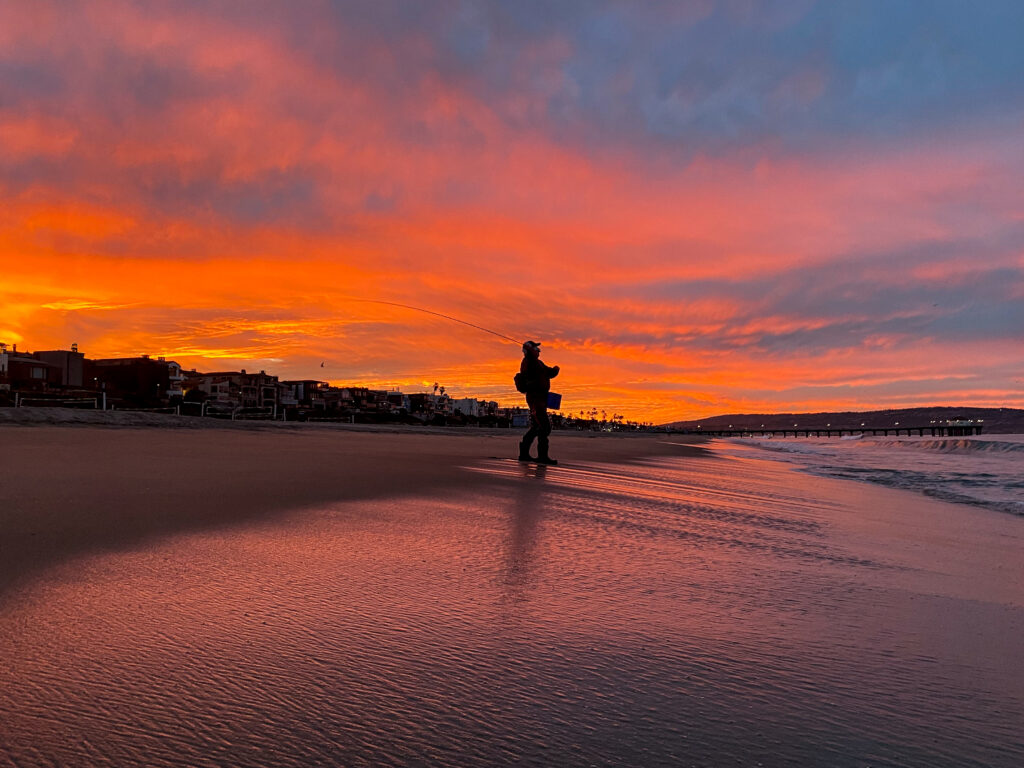
Al Q shares these tips for getting beans:
“While many anglers head inland for trout, savvy fly fishers are stalking corbina just steps from the Pacific Coast Highway. As soon as our flowering purple Jacaranda trees begin to bloom, the corbina start their way to the shallow surf line in search of sand crabs. And let me tell you, sight-fishing for these elusive fish in the surf is pure adrenaline.”
Summer is when corbina move into the skinny water, eating sand crabs in very shallow surf. “These fish are fast, skittish, and bladder-less (yep, no swim bladder!), making them ideal for shallow sight-casting while spotting their backs as they slide through a set and pounce on sand crab beds,” shares Al. “Look for tiny V-shaped ripples from sand crabs as waves recede, or bird tracks—they’re nature’s best fish finders. Where there’s food, there’s fish.”
Gear Up for the Surf
Fly fishing the surf doesn’t require much—just the right mindset and a few key pieces of gear.
Al Q suggests, “You’ll want to simply wear a pair of flip flops or even go barefoot during summer months. Throw a 5-7 weight rod with a sealed-drag reel loaded with a 200-grain, 27-foot sinking head over 150+ yards of 30-pound Dacron backing. Round out the ensemble with polarized sunglasses, a hat, a stripping basket, and of course a solid attitude.”
“Stretch and wet your fly line before casting—it’ll shoot better. And keep that waterproof camera ready. Corbina aren’t just fun to catch, they’re definitely worth a brag shot,” advises Al Q.
Your fly box should feature sand crab patterns like Surfin’ Merkins and Holy Moleys (gray or salmon pink work great), or even small shrimp-style bonefish flies, all tied hook up clouser-style. Go for size #4 or #6 hooks.
“No need for tapered leaders, just a 7-foot length of 8-12-pound fluorocarbon will get the job done. It’s best to tie on your fly with a non-slip loop knot, which allows the fly to move naturally and sink fast. Vary your retrieve speed until the fish show interest. And always keep moving. This is a cover-ground, stay-alert game,” says Al Q.
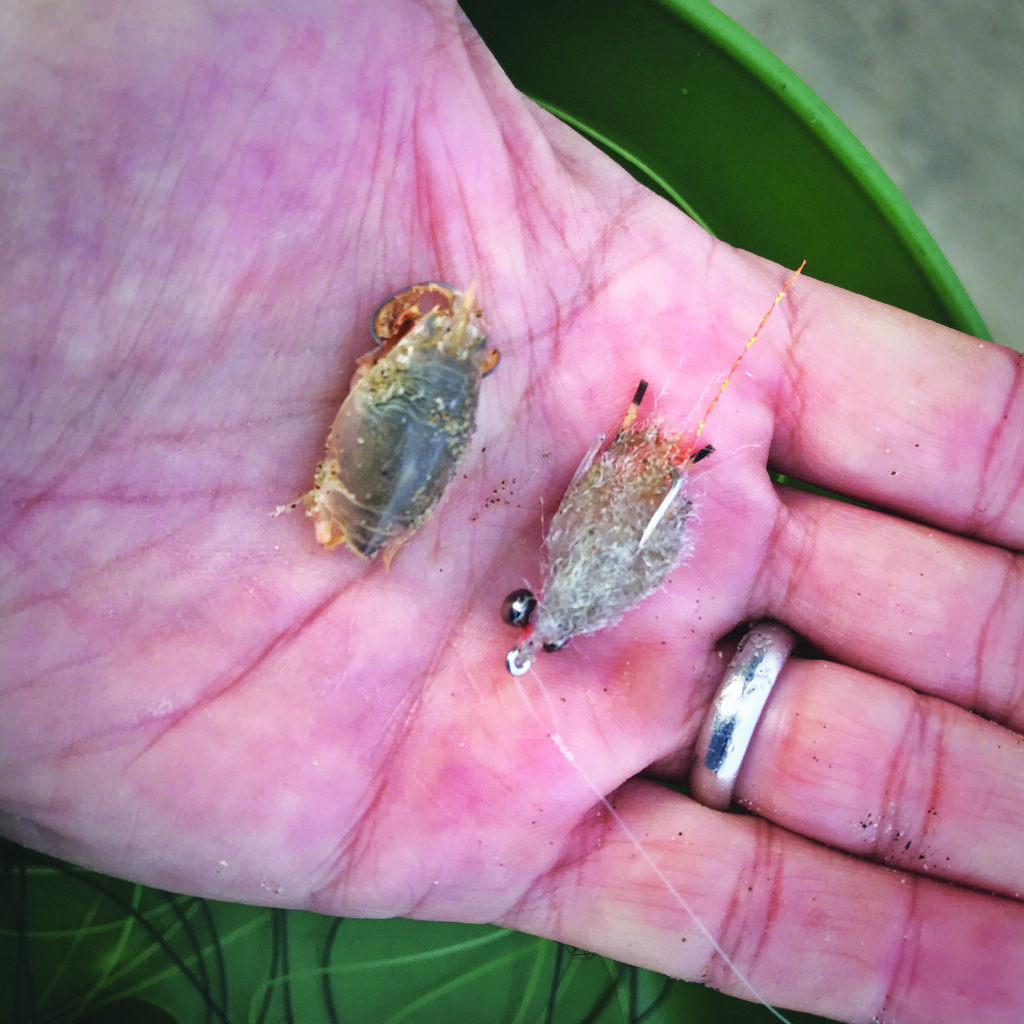
Cast Like a Local
Perfecting the double haul will make a big difference, allowing you to stay on dry sand and cast further. The Belgian oval cast is another must-have, especially when using a sinking shooting head. This cast keeps your fly away from your face, but be mindful of your back cast. California beaches are busy places, and tangled lines with sunbathers or dogs are no fun. Early mornings after a low tide offer the most solitude and clean conditions. Always pinch your barbs, handle fish gently, and use the waves to help land and release your catch. Revive them in ankle-deep water until they swim off strong.
“Always point your rod tip low, right at the surf, and strip so you feel the end of your line. That tight line is the secret to sticking Corbina when they take. Just remember to feel your fly. Any slack or side current, and you’re out of the game,” concludes Al Q.
From Surf to Rivers and Lakes
Urban fly fishing in Los Angeles may seem improbable to outsiders, but for more than 40 years, Lino Jubilado has explored, fished, and fallen in love with the hidden angling opportunities nestled in the heart of the sprawling metropolis. From concrete-lined riverbeds to revitalized city lakes, Los Angeles offers a unique and world-class fishery that blends challenge, accessibility, culture, and community.
THE L.A. RIVER
The L.A. River? Yes, the revitalized waterway that traverses much of Los Angeles provides a unique fishing opportunity.
“Many are surprised to learn that the Los Angeles River was once the area’s primary source of food and water. Today, despite its hardened banks and urban reputation, it’s regaining life as a thriving fishery—especially for fly anglers targeting ‘sewer salmon,’ the affectionate nickname for the powerful, elusive carp. These fish, some over 20 pounds, are a favorite of mine, offering thrilling fights on the fly,” Lino explains.
The water flowing through the concrete-lined riverbeds crisscrossing Southern California and L.A.’s urban lakes—such as Echo Park Lake, MacArthur Park Lake, and Lincoln Park Lake—comes from a combination of sources: natural springs, storm water runoff, and segments of the Los Angeles River. These lakes are regularly stocked with trout in the winter and catfish in the summer, further enhancing the variety of species available to the urban angler.
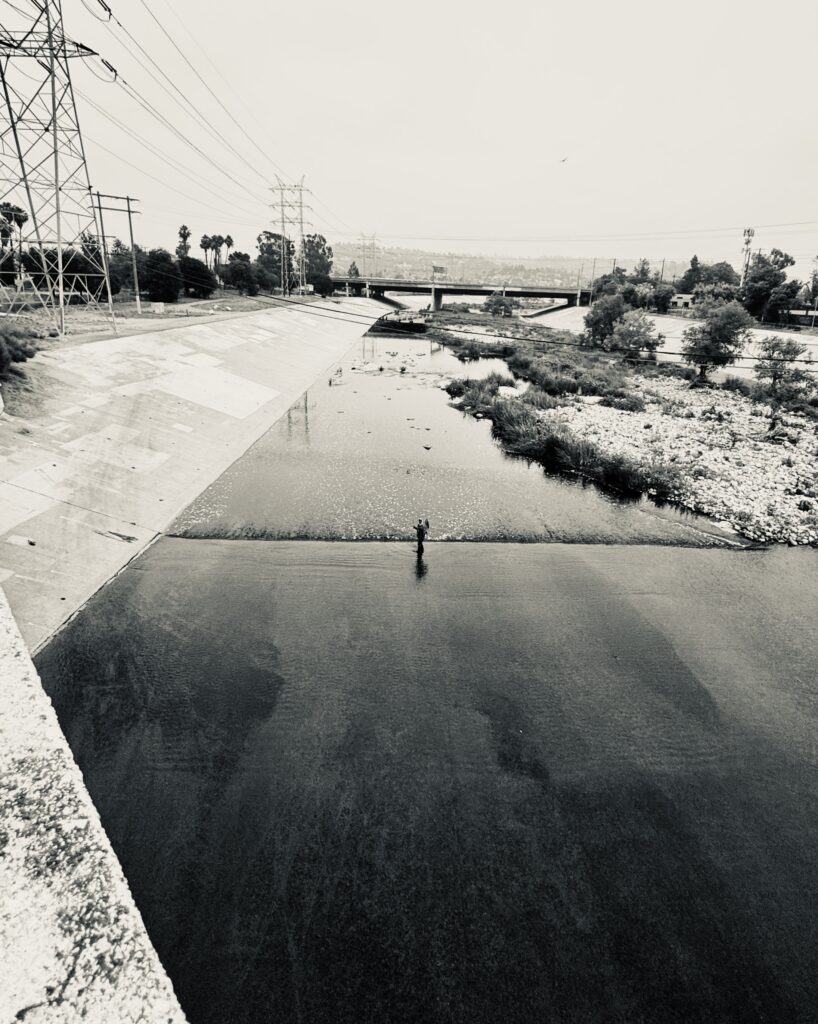

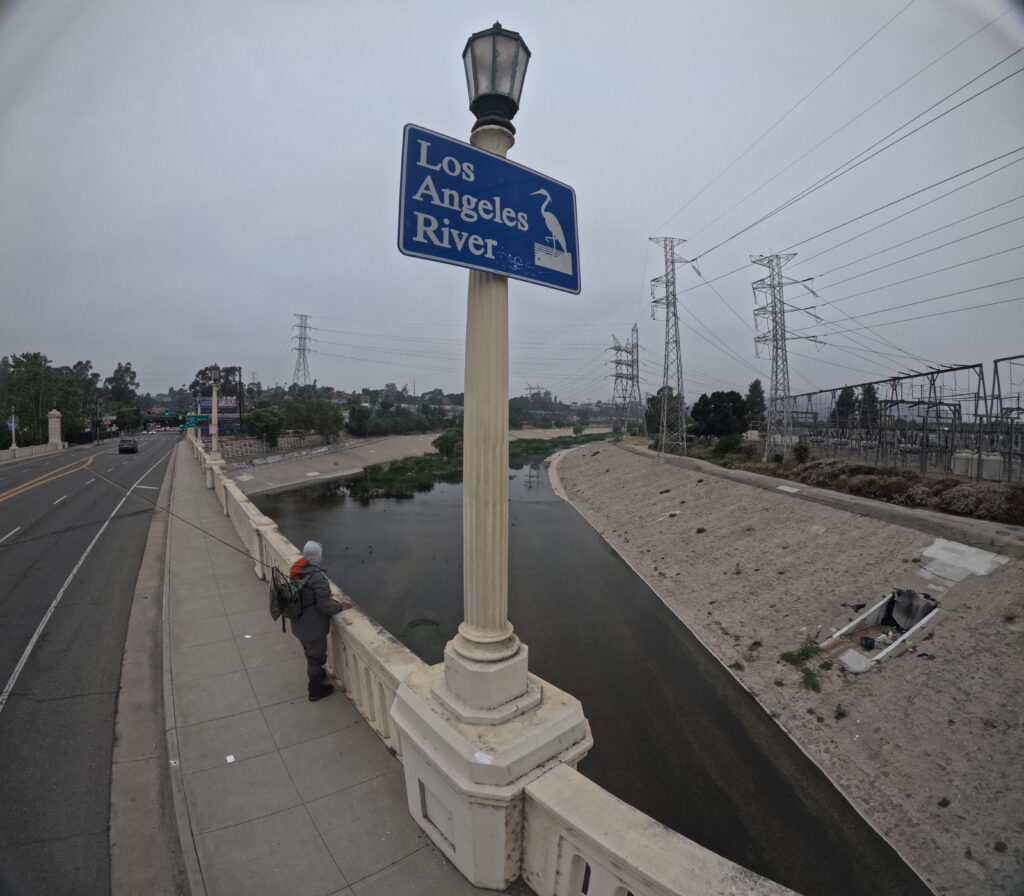
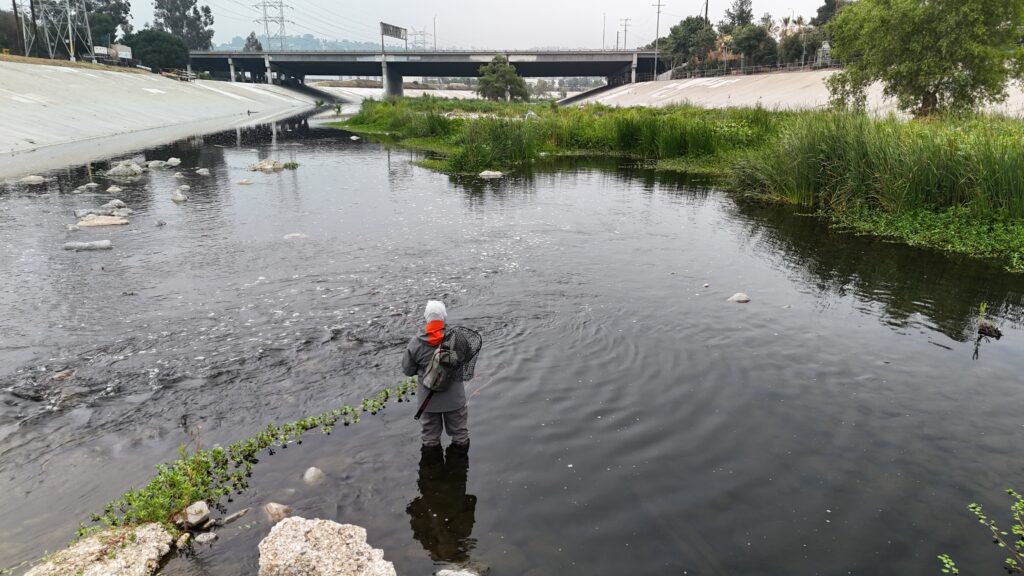
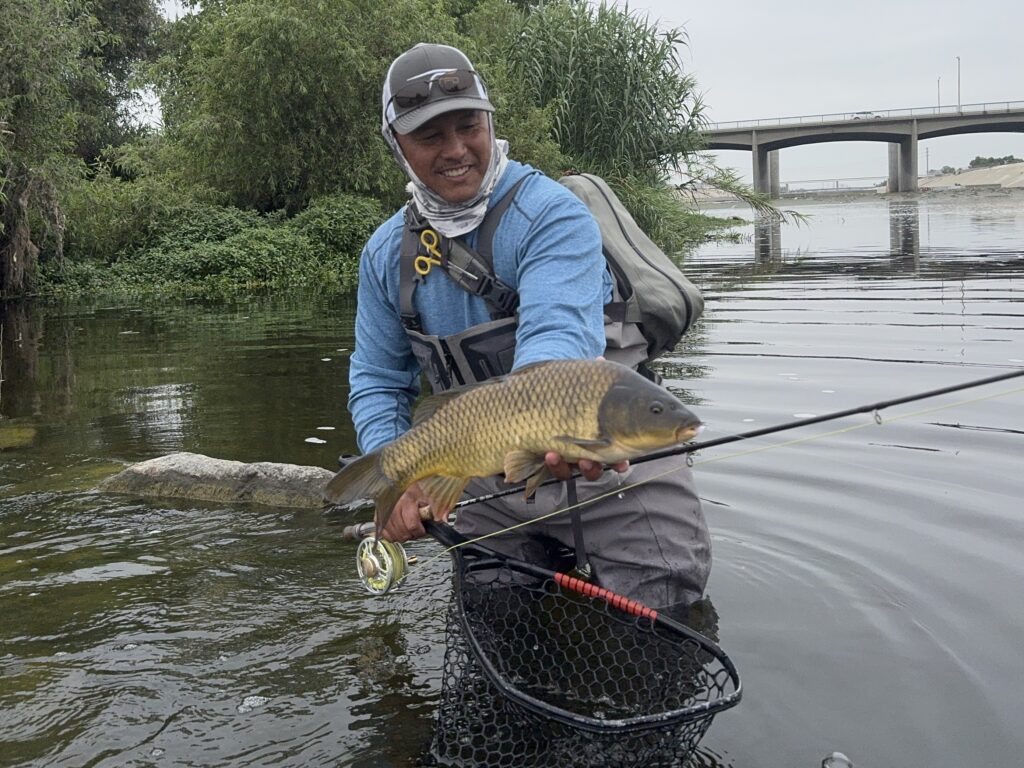
Gear
Along the rivers and lakeshores, Lino uses a 6-weight rod loaded with floating line and 1.5-2 feet of 12-pound fluorocarbon leader with 5 feet of 10-pound fluorocarbon tippet. The surgeon’s knot connecting the leader rig keeps the indicator above from slipping. His fly is one of his own. Time on the water led him to develop three signature fly patterns: the Skunk Buster, inspired by the crappie jig rather than traditional “match the hatch” flies, the Beach Buster, a variant of the Skunk Buster but designed specifically for the salt with a hard resin body and dumbbell eyes, and the Eggs and Ham fly, a playful take on an egg fly. This fly has helped many anglers land their first urban L.A. carp.
Timing
With the demands of everyday life keeping him busy, Lino enjoys the everyday accessibility of L.A.’s urban waters. The only real obstacle? Traffic. His tip: Fish early, leave late—or accept the crawl on the return. It’s worth it.
Community
Lino has worked hard to share and introduce hundreds of anglers from all over the world to the hidden waters of Los Angeles. He mentors foster youth through The Mayfly Project and supports women in fly fishing through groups like United Women on the Fly and Celine’s Fly Gals Weekend. He’s even hosted a fly-fishing event at Echo Park Lake where anglers fished from swan pedal boats, and he’s been featured in short films to raise awareness of the Los Angeles River’s beauty and fragility.
“Having spent decades fly fishing in these waters, I can confidently say L.A. is a world-class destination. I’ve caught my personal best bass—over 8 pounds—from Echo Park Lake, 20+ pound carp at MacArthur Park, massive leopard sharks in the surf, and corbina, often referred to as our Southern California bonefish. I’ve even caught striped bass up to 20 pounds from L.A.’s beaches,” says Lino. In fact, where else can you complete a “Surf and Turf Grand Slam—catching a leopard shark and corbina from the surf, then a carp from the L.A. River—all before 10:00 a.m.? Lino has, and it’s one of his proudest achievements.
OFF-SHORE OPPORTUNITIES
The coastline of L.A. affords some of the most beautiful vistas for watching the perfect postcard sunsets. But just a short distance offshore is where Captain Vaughn Podmore of Salty Fly Guide Service plies his trade. Experience at “The Wall,” a mile-long stretch of rocks that protects the L.A. Harbor and beyond, has shown Captain Vaughn how to get larger model calico bass to eat a fly, as he explains:
“Working The Wall is really a matter of timing and using the right gear, but it fishes year-round. I tie on an orange sculpin pattern with a weed guard, and fish early when light is low, greylight. I use an 8-weight rod with a 6-foot 20-pound fluorocarbon leader tied to a 350-grain sinking head. Casting up along the rock pile of the breakwater, the retrieve drops the fly down along the pile and into deeper water. The rip comes pretty quickly and can be surprisingly strong.”
Fishing from his New Robalo 246 Cayman center console, Captain Vaughn has learned that fighting feisty calico along the rocks inside or outside the L.A. Breakwater can be very productive. Catching and releasing 30 to 50 fish in a trip is not uncommon.
“But, for real excitement, we run offshore to Santa Catalina Island and fish for yellowtail, bonito, barracuda, and of course, calico. Using pretty much the same gear, maybe a longer leader, and switching to a baitfish imitation like the Sardinia pattern that I tie. These fish can be elusive, but once you find them, they will take a fly,” shares Captain Vaughn.
VARIETY THAT KEEPS YOU COMING BACK FOR MORE
Chasing fish on the fly in Los Angeles is both exciting and very rewarding. With countless locations to explore—from mountain streams to urban park lakes to fish-rich surf—the city offers an unmatched variety of environments and species, many more than the singular species targeted in the city by the Bay, making Los Angeles, hands down, the fishiest city.
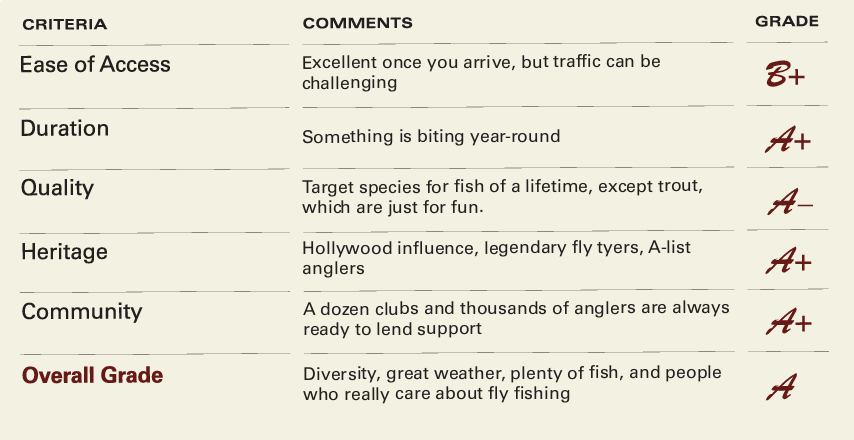
For additional resources on fishing in Los Angeles, click here for a 24-hour guide to L.A.
L.A. Adjacent
Gazing to the east or north from atop the Hollywood Hills, any fly angler will see incredible fishing potential in the mountains surrounding the Los Angeles basin. The San Gabriel Mountain foothills are a short distance along the 210 freeway, high above Azusa, and home to the East and West Forks of the San Gabriel River. Further off are the San Bernardino Mountains, still reachable for a day’s outing. To the north are the lower Los Padres National Forest and the western edge of the Angeles National Forest.
Bernard Yin has fished these waters for many years, and his experience and skills in mountain stream fishing are recognized around Southern California. Here, he shares some pointers for getting trout just beyond the L.A. sprawl:
San Gabriel Mountains
“For many, this is the spot where the first trout was caught as a youth, and today holds fish worthy of the adventure. The forks of the San Gabriel River (more like creeks) have self-sustaining trout populations. The majority of the West Fork between Highway 39 and Cogswell Reservoir is designated a catch-and-release fishery, and the further you hike (or bike) along it, the better the fishing and the fewer people you’ll run into. This, and the other forks, are prone to weekend warriors having their picnics to such a degree that it can make you wonder if you ever left the city. If you have flexibility, I recommend fishing anywhere in the L.A. region on weekdays only,” advises Bernard.
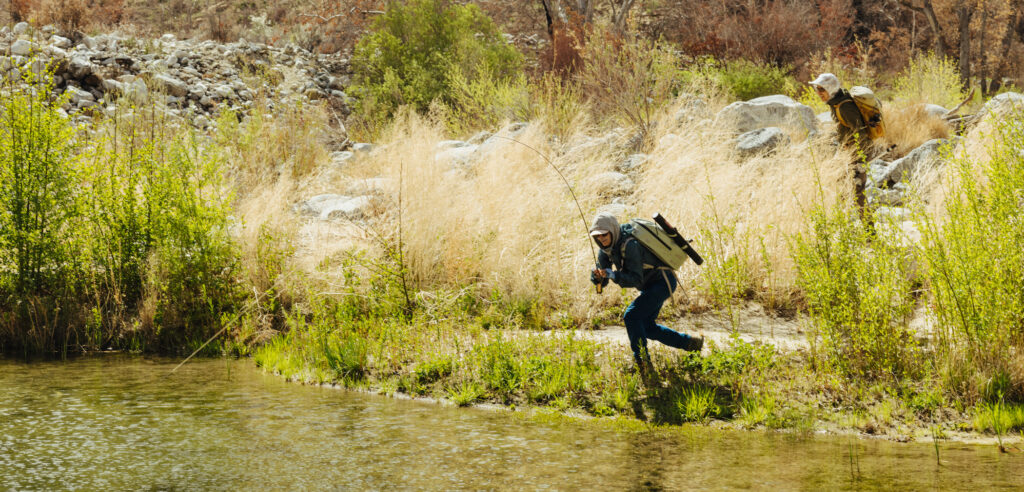
San Bernardino Mountains
A little further to the east are these equally gnarly mountains. Mount San Gorgonio lives in this range and is the highest peak in Southern California’s transverse ranges at 11,503 feet. Like the San Gabriel Mountains, snowmelt factors in, and some of these streams stay icy all year. The Santa Ana River, Bear Creek, and Deep Creek are well-known destinations for the fly angler. It’s not unusual to run into brown trout in this region. Interestingly, the Pacific Crest Trail follows a good stretch of Deep Creek. A stretch of the South Fork Santa Ana River near Seven Oaks does receive planted fish and isn’t a bad spot to introduce someone to fly fishing in SoCal.
North of L.A.
Anglers can fish in the lower Los Padres National Forest as well as western edge of the Angeles National Forest. Here, the Piru Creek drainage serves as the easiest resource for a fly-fishing fix. With its headwaters in the San Emigdio Mountains (another transverse range) and its rugged path through two reservoirs and deep canyons, it can truly keep the angler busy. See the Fall 2024 issue of California Fly Fisher for more on this watershed. There currently is no stocking anywhere within the drainage except for Pyramid Lake. As with anywhere, please respect these wild and self-sustaining trout.
Spring is generally the best season to fish the foothills. During warmer months, be on guard for rattlesnakes, carry water or a water filter, bug repellent, layers, sun protection, and preferably a lighter and shorter fly rod. No hero casts required, and given that most fish run smallish (11” is considered large), this is a great place to put your 3-weight to use. Beadhead nymphs, dries such as Elk Hair Caddis, Adams, terrestrials, and Woolly Buggers are fine. A basic indicator rig or hopper-dropper setup is also effective. These fish are rarely selective, and a basic ‘Western’ fly arsenal will serve you well.
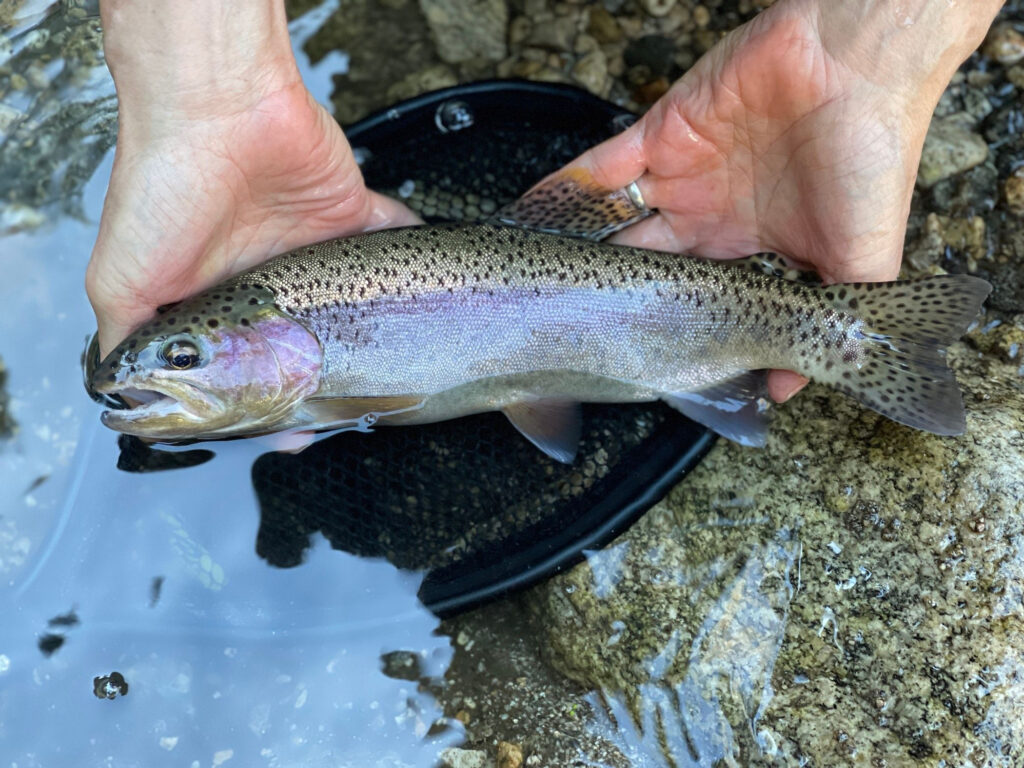
Exploring the local mountains requires some planning and a little extra gear for your safety and well-being. Taking a few minutes in advance can ensure that your trip is both fun and successful. As with any trek into mountainous areas, it is best to bring a partner or leave word of your intended plans with people back home. Be sure to check the regulations for the area and fish barbless.
Editor’s Note: We’d sincerely like to thank Al Quattrocchi, Lino Jubilado. Bernard Yin, and Vaughn Podmore, for their invaluable contributions to this L.A. Story. Also, we’d like to extend our heartfelt support and condolences to those around Los Angeles who have suffered because of the devastating fires of this past January. Together these fires caused the loss of 16,251 structures, and the burning of over 55,000 acres, including areas of South Malibu that remain closed to the public.



